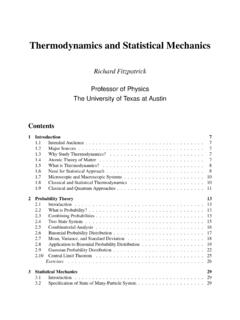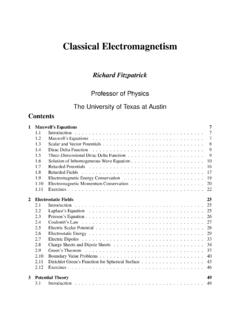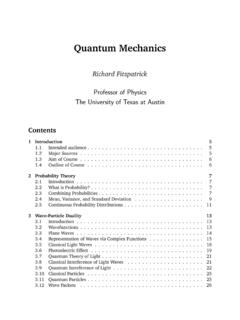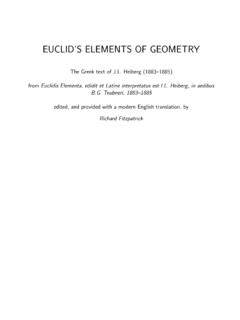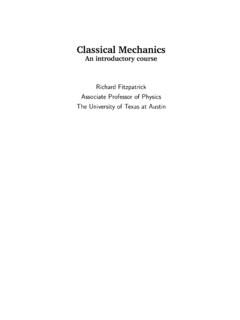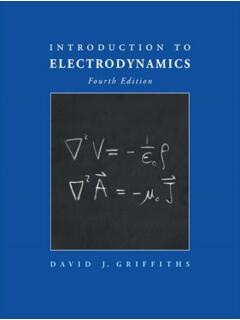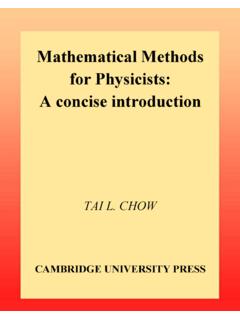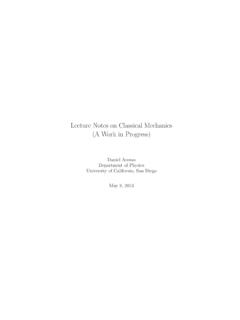Transcription of Classical Electromagnetism
1 Classical Electromagnetism Richard Fitzpatrick Professor of Physics The University of Texas at Austin Contents 1 Maxwell's equations 7. Introduction .. 7. Maxwell's equations .. 7. Scalar and Vector Potentials .. 8. Dirac Delta Function .. 9. Three-Dimensional Dirac Delta Function .. 9. Solution of Inhomogeneous Wave Equation .. 10. Retarded Potentials .. 16. Retarded Fields .. 17. Electromagnetic Energy Conservation .. 19. Electromagnetic Momentum Conservation .. 20. Exercises .. 22. 2 Electrostatic Fields 25. Introduction .. 25. Laplace's Equation .. 25. Poisson's Equation .. 26. Coulomb's Law .. 27. Electric Scalar Potential .. 28. Electrostatic Energy .. 29. Electric Dipoles .. 33. Charge Sheets and Dipole Sheets .. 34. Green's Theorem .. 37. Boundary Value Problems .. 40. Dirichlet Green's Function for Spherical Surface.
2 43. Exercises .. 46. 3 Potential Theory 49. Introduction .. 49. 2 Classical Electromagnetism . Associated Legendre Functions .. 49. Spherical Harmonics .. 50. Laplace's Equation in Spherical Coordinates .. 51. Poisson's Equation in Spherical Coordinates .. 52. Multipole Expansion .. 53. Axisymmetric Charge Distributions .. 56. Dirichlet Problem in Spherical Coordinates .. 57. Newmann Problem in Spherical Coordinates .. 58. Laplace's Equation in Cylindrical Coordinates .. 59. Poisson's Equation in Cylindrical Coordinates .. 64. Exercises .. 69. 4 Electrostatics in Dielectric Media 73. Polarization .. 73. Boundary Conditions for E and D .. 75. Boundary Value Problems with Dielectrics .. 75. Energy Density Within Dielectric Medium .. 81. Force Density Within Dielectric Medium .. 82. Clausius-Mossotti Relation.
3 85. Dielectric Liquids in Electrostatic Fields .. 86. Exercises .. 89. 5 Magnetostatic Fields 93. Introduction .. 93. Biot-Savart Law .. 93. Continuous Current Distribution .. 93. Circular Current Loop .. 95. Localized Current Distribution .. 98. Exercises .. 100. 6 Magnetostatics in Magnetic Media 103. Magnetization .. 103. Magnetic Susceptibility and Permeability .. 104. Ferromagnetism .. 105. Boundary Conditions for B and H .. 107. Permanent Ferromagnets .. 108. Uniformly Magnetized Sphere .. 110. Soft Iron Sphere in Uniform Magnetic Field .. 113. Magnetic Shielding .. 114. Magnetic Energy .. 116. Exercises .. 117. 7 Wave Propagation in Uniform Dielectric Media 119. CONTENTS 3. Introduction .. 119. Form of Dielectric Constant .. 120. Anomalous Dispersion and Resonant Absorption .. 122. Wave Propagation in Conducting Media.
4 124. High Frequency Limit .. 126. Polarization of Electromagnetic Waves .. 127. Faraday Rotation .. 128. Wave Propagation in Magnetized Plasmas .. 131. Wave Propagation in Dispersive Media .. 132. Wave-Front Propagation .. 136. Sommerfeld Precursor .. 139. Method of Stationary Phase .. 144. Group Velocity .. 145. Brillouin Precursor .. 147. Signal Arrival .. 149. Exercises .. 150. 8 Wave Propagation in Inhomogeneous Dielectric Media 153. Introduction .. 153. Laws of Geometric Optics .. 153. Fresnel Relations .. 155. Total Internal Reflection .. 161. Reflection by Conducting Surfaces .. 166. Ionospheric Radio Wave Propagation .. 167. WKB Approximation .. 168. Reflection Coe cient .. 172. Extension to Oblique Incidence .. 173. Ionospheric Pulse Propagation .. 177. Measurement of Ionospheric Electron Density Profile.
5 179. Ionospheric Ray Tracing .. 180. Asymptotic Series .. 183. WKB Solution as Asymptotic Series .. 188. Stokes Constants .. 189. WKB Reflection Coe cient .. 194. Je ries Connection Formula .. 197. Exercises .. 198. 9 Radiation and Scattering 201. Introduction .. 201. Basic Antenna Theory .. 201. Antenna Directivity and E ective Area .. 204. Antenna Arrays .. 208. Thomson Scattering .. 210. 4 Classical Electromagnetism . Rayleigh Scattering .. 212. Exercises .. 213. 10 Resonant Cavities and Waveguides 215. Introduction .. 215. Boundary Conditions .. 215. Cavities with Rectangular Boundaries .. 217. Quality Factor of a Resonant Cavity .. 218. Axially Symmetric Cavities .. 219. Cylindrical Cavities .. 222. Waveguides .. 223. Dielectric Waveguides .. 225. Exercises .. 230. 11 Multipole Expansion 231. Introduction.
6 231. Multipole Expansion of Scalar Wave Equation .. 231. Angular Momentum Operators .. 233. Multipole Expansion of Vector Wave Equation .. 234. Properties of Multipole Fields .. 237. Solution of Inhomogeneous Helmholtz Equation .. 240. Sources of Multipole Radiation .. 242. Radiation from Linear Centre-Fed Antenna .. 245. Spherical Wave Expansion of Vector Plane Wave .. 248. Mie Scattering .. 250. Exercises .. 254. 12 Relativity and Electromagnetism 255. Introduction .. 255. Relativity Principle .. 255. Lorentz Transformation .. 256. Transformation of Velocities .. 260. Tensors .. 261. Physical Significance of Tensors .. 265. Space-Time .. 266. Proper Time .. 270. 4-Velocity and 4-Acceleration .. 271. Current Density 4-Vector .. 272. Potential 4-Vector .. 273. Gauge Invariance .. 274. Retarded Potentials.
7 274. Tensors and Pseudo-Tensors .. 276. Electromagnetic Field Tensor .. 278. CONTENTS 5. Dual Electromagnetic Field Tensor .. 281. Transformation of Fields .. 283. Potential Due to a Moving Charge .. 284. Field Due to a Moving Charge .. 285. Relativistic Particle Dynamics .. 286. Force on a Moving Charge .. 288. Electromagnetic Energy Tensor .. 289. Accelerated Charges .. 292. Larmor Formula .. 295. Radiation Losses .. 299. Angular Distribution of Radiation .. 300. Synchrotron Radiation .. 301. Exercises .. 304. 6 Classical Electromagnetism . Maxwell's equations 7. 1 Maxwell's equations Introduction This chapter gives a general overview of Maxwell's equations . Maxwell's equations All Classical ( , non-quantum) electromagnetic phenomena are governed by Maxwell's equa- tions, which take the form . E= , ( ). 0.
8 B = 0, ( ). B. E= , ( ). t E. B = 0 j + 0 0 . ( ). t Here, E(r, t), B(r, t), (r, t), and j(r, t) represent the electric field-strength, the magnetic field- strength, the electric charge density, and the electric current density, respectively. Moreover, 0 = 10 12 C 2 N 1 m 2 ( ). is the electric permittivity of free space, whereas 0 = 4 10 7 N A 2 ( ). is the magnetic permeability of free space. As is well known, Equation ( ) is equivalent to Coulomb's law (for the electric fields generated by point charges), Equation ( ) is equivalent to the statement that magnetic monopoles do not exist (which implies that magnetic field-lines can never begin or end), Equation ( ) is equivalent to Faraday's law of electromagnetic induction, and Equation ( ) is equivalent to the Biot-Savart law (for the magnetic fields generated by line currents) augmented by the induction of magnetic fields by changing electric fields.
9 Maxwell's equations are linear in nature. In other words, if and j j, where is an arbitrary (spatial and temporal) constant, then it is clear from equations ( ) ( ) that E E. and B B. The linearity of Maxwell's equations accounts for the well-known fact that the electric fields generated by point charges, as well as the magnetic fields generated by line currents, are superposable. Taking the divergence of Equation ( ), and combining the resulting expression with Equa- tion ( ), we obtain . + j = 0. ( ). t 8 Classical Electromagnetism . In integral form, making use of the divergence theorem, this equation becomes . d dV + j dS = 0, ( ). dt V S. where V is a fixed volume bounded by a surface S . The volume integral represents the net electric charge contained within the volume, whereas the surface integral represents the outward flux of charge across the bounding surface.
10 The previous equation, which states that the net rate of change of the charge contained within the volume V is equal to minus the net flux of charge across the bounding surface S , is clearly a statement of the conservation of electric charge. Thus, Equa- tion ( ) is the di erential form of this conservation equation. As is well known, a point electric charge q moving with velocity v in the presence of an electric field E and a magnetic field B experiences a force F = q (E + v B). ( ). Likewise, a distributed charge distribution of charge density and current density j experiences a force density f = E + j B. ( ). Scalar and Vector Potentials We can automatically satisfy Equation ( ) by writing B = A, ( ). where A(r, t) is termed the vector potential. Furthermore, we can automatically satisfy Equa- tion ( ) by writing A.
